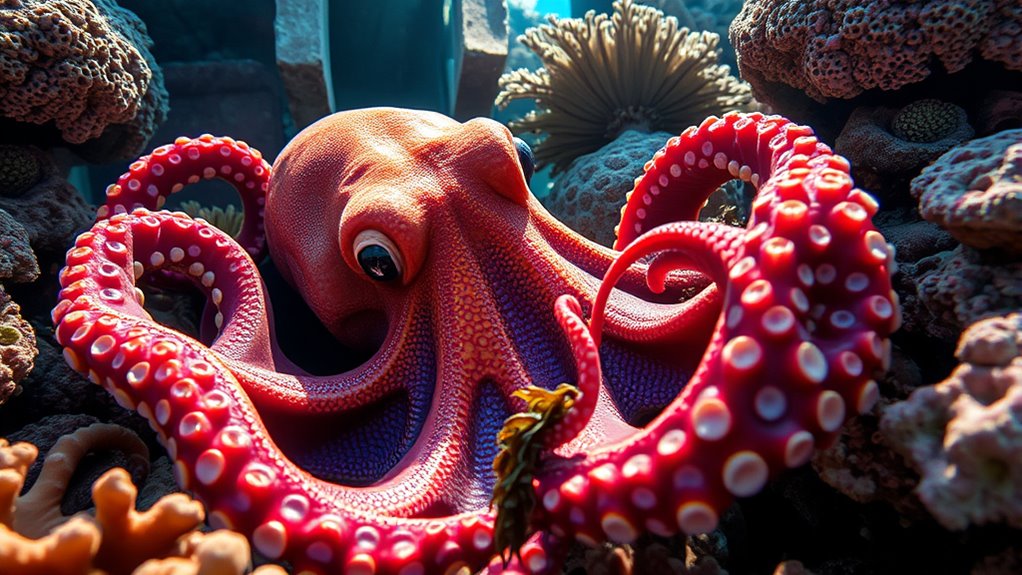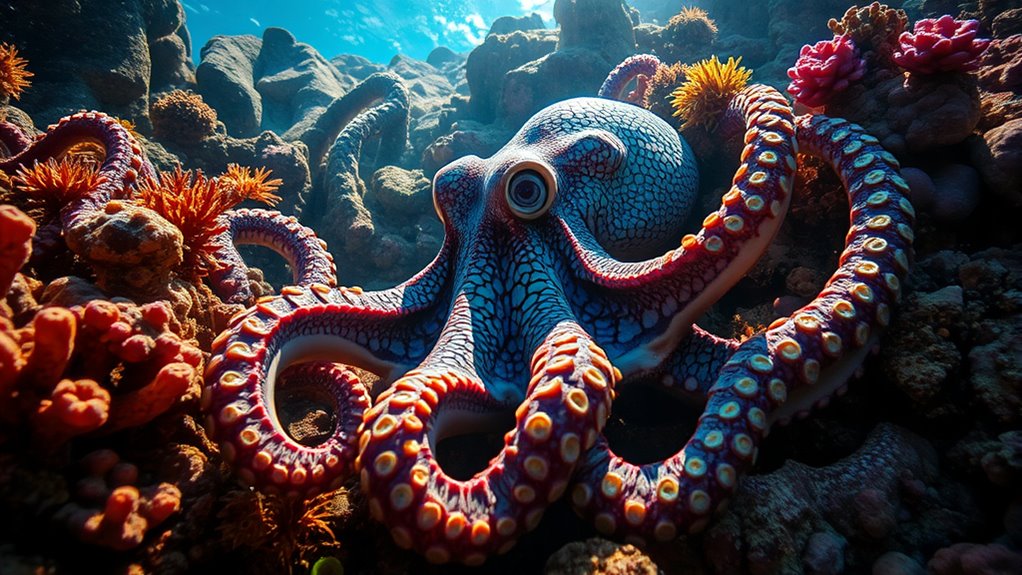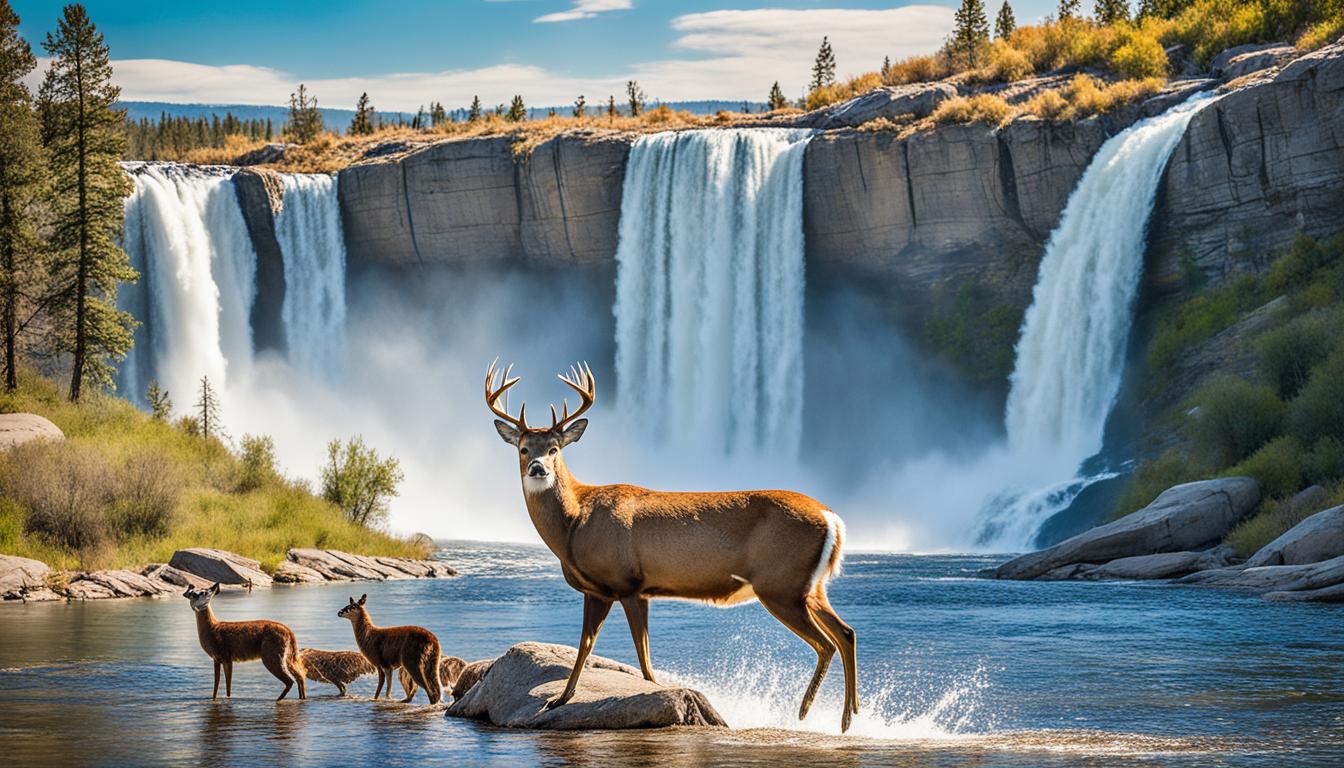The Giant Pacific Octopus truly embodies the art of disguise in the animal kingdom. With its incredible ability to change color and texture, it seamlessly blends into rocky reefs and ocean floors. This master of camouflage not only evades predators but also uses its skills for hunting. It’s a marvel of evolution, showcasing intelligence and adaptability. If you’re curious to discover more about its unique behaviors and survival tactics, there’s plenty more to explore.
Key Takeaways
- The Giant Pacific Octopus can instantly change its skin color and texture to blend seamlessly with its surroundings.
- This cephalopod employs vibrant flashes of color as part of its camouflage strategy for hunting and evading predators.
- Its remarkable ability to mimic rocky reefs makes it difficult for both prey and predators to identify it.
- Quick shifts in appearance showcase its mastery of disguise, refined over millions of years of evolution.
- The octopus’s adaptations inspire technological innovations and highlight the importance of understanding marine biodiversity.

Have you ever wondered what it’s like to encounter a Giant Pacific Octopus? Picture yourself diving into the cool, blue waters of the Pacific Northwest, where these fascinating creatures reside. As you explore the rocky reefs, you might catch a glimpse of something incredible – a vibrant flash of color, or perhaps a sudden shift in texture. That’s the magic of marine camouflage at work, a skill that the Giant Pacific Octopus has perfected over millions of years.
These remarkable cephalopods can change their skin color and texture in the blink of an eye. When you spot one, it might look like a part of the ocean floor, blending seamlessly with its surroundings. This ability isn’t just for show; it’s an essential survival mechanism. Whether they’re hunting for prey or evading predators, their skillful use of marine camouflage makes them masters of disguise. You might find it hard to believe that what you’re looking at is a living creature and not just a part of the reef!
Masters of disguise, Giant Pacific Octopuses seamlessly blend into their surroundings, showcasing nature’s artistry in survival.
As you observe this octopus, you can’t help but marvel at its intelligence. Cephalopod intelligence is often regarded as one of the highest among invertebrates. These creatures have complex nervous systems and exhibit behaviors that suggest problem-solving abilities. Imagine watching as a Giant Pacific Octopus navigates through intricate mazes or uses tools to access hard-to-reach food. Their curiosity is evident; they’ll investigate their surroundings with their dexterous arms, exploring every nook and cranny. You may even witness one opening a jar to retrieve a tasty snack, showcasing not just intelligence but also impressive dexterity.
If you’re lucky enough to get close, you might see how they interact with their environment. They can squirt ink to create a smokescreen, allowing them to make a quick escape. This kind of quick thinking is just one example of how their intelligence plays an essential role in survival. You may even feel a sense of awe as you realize you’re witnessing a creature that’s not just a marvel of nature but also a testament to evolution’s creativity. In fact, understanding their incredible adaptability can inspire us to think about how we can harness technology to solve complex problems.
In a world where many animals rely on brute strength, the Giant Pacific Octopus stands out as a symbol of adaptability and cunning. So, the next time you find yourself by the ocean, take a moment to appreciate the incredible world beneath the waves, where the Giant Pacific Octopus reigns supreme.
Frequently Asked Questions
How Long Do Giant Pacific Octopuses Typically Live?
Giant Pacific octopuses typically live around 3 to 5 years. Their lifespan duration is relatively short compared to other marine creatures. As you observe them, you’ll notice their fascinating aging process; they often reproduce only once, after which they may decline rapidly. This unique life cycle means that while they’re vibrant and active, their time is limited, making every moment in their presence quite special and intriguing.
What Do Giant Pacific Octopuses Eat in the Wild?
Giant Pacific octopuses primarily eat crabs, shrimp, and fish in the wild. You’ll notice their impressive mating behaviors, where they showcase their colorful camouflage techniques to attract mates. When hunting, they use their ability to blend into the environment, sneaking up on prey. This stealth not only helps them catch food but also plays a role in their mating rituals, making them fascinating creatures of the ocean.
Are Giant Pacific Octopuses Solitary or Social Creatures?
Giant Pacific octopuses are primarily solitary seekers, shunning social scenes for most of their lives. However, during mating season, their social interactions spark. Males and females engage in intricate mating behavior, showcasing their unique personalities. After this brief bonding, they typically part ways, returning to their independent lifestyles. So, while they may momentarily mingle, these mesmerizing mollusks prefer a peaceful, solitary existence most of the time.
How Do Giant Pacific Octopuses Reproduce?
Giant Pacific octopuses reproduce through a fascinating process. During octopus courtship, the male approaches the female, using his specialized arm to transfer sperm packets. After mating, the female lays thousands of eggs and incubates them in a safe location, often for several months. During this time, she doesn’t eat and protects her eggs fiercely. Once the eggs hatch, she usually dies, having devoted her energy to the next generation.
What Threats Do Giant Pacific Octopuses Face in Their Habitat?
Giant Pacific octopuses face threats that could make even the bravest diver shiver! Marine pollution invades their watery homes, turning vibrant ecosystems into toxic wastelands. Plus, these incredible creatures have to dodge predators like sharks and sea lions, always on the hunt. With their survival at stake, you can imagine the constant stress they endure. Protecting their habitat is essential, or we might lose these fascinating masters of disguise forever!
Conclusion
In summary, the Giant Pacific Octopus truly is a master of disguise, showcasing incredible adaptability in its underwater world. Did you know these remarkable creatures can change color and texture in mere seconds, with over 200 different chromatophores at their disposal? This ability not only helps them evade predators but also plays a crucial role in communication and hunting. As you explore the ocean’s depths, remember that these intelligent beings are a proof of nature’s ingenuity and resilience.










